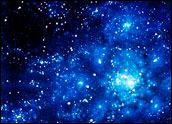
An international group of scientists from universities in various parts of the world known as the Dark Energy Survey had a Dark Energy Camera (DECam) built in order to find out what dark energy is.
Dark energy has been posited to be the reason for the universe’s expanding faster and faster.
DECam took its first pictures of the southern sky recently.
DECam’s Mighty Optics
DECam is a 570 MP camera that will have 74 charge-coupled devices (CCDs). These are made to be sensitive to the redshifted light from distant galaxies and stars.
The camera has a 2.2 degree field of view. It can record data from an area of the sky 20 times the size of the moon as seen from the Earth in one image.
For such a wide field of view, DECam has to use a system of five specially shaped lenses, the largest of which is almost one meter in diameter.
DECam can record light from more than 100,000 galaxies up to 8 billion light-years away.
The camera is the size of a phone booth. It is mounted on the Victor M. Blanco telescope at the United States National Science Foundation’s Cerro Tololo Inter-American Observatory in Chile.
Using Decam
Dark Energy Survey scientists will use four methods of looking for dark energy with DECam. These are studying galaxy clusters, supernovae, the large-scale clumping of galaxies, and weak gravitational lensing.
“By having four measures, one can reduce uncertainties and be sure there is not some unknown problem with one of the methods,” Gillian Wilson, a professor in the department of physics and astronomy at the University of California, Riverside, told TechNewsWorld.
These four measurements “are sensitive to the two primary observable effects of dark energy — dark energy changes the expansion rate of the universe over time, and the repulsive action of dark energy competes against the attractive nature of gravity, which is the force that makes galaxies and larger structure form,” Josh Frieman, Dark Energy Survey director, who’s also a Fermilab scientist and a professor at the University of Chicago, said.
How the Process Works
Scheduled to kick off in December, the Dark Energy Survey will create a detailed color image of one-eighth of the sky, or 5,000 square degrees over the next five years. It will discover and measure 300 million galaxies, 100,000 galaxy clusters and 4,000 supernovae.
Pictures it takes will be sent nightly to various U.S. national supercomputing facilities, including the National Center for Supercomputing Applications (NCSA) at the University of Illinois, for processing, Frieman told TechNewsWorld.
Dark Energy Survey members “have developed a lot of software to analyze the data and are continuing to refine the algorithms,” Frieman continued. They also make use of existing software where possible.
“We could have some early science results some time in 2013,” Frieman remarked. “It will probably take a couple of years for our first results on dark energy.”
Why Dark Energy?
Dark energy is the most widely accepted hypothesis to explain observations that the universe is expanding faster and faster. In the standard model of cosmology, dark energy accounts for 73 percent of the total mass-energy of the universe.
“Cosmologists have very little understanding of what is pushing on the universe and causing it to expand,” UC Riverside’s Wilson said.
“The dark energy survey, along with several other projects getting under way, aim to give us a more precise understanding of how dark energy behaves,” James Rhoads, an associate professor at Arizona State University’s School of Earth and Space Exploration, told TechNewsWorld.
“The data we presently have allow the possibility that its density changes by perhaps as much as 20 percent every time the universe doubles in size,” Rhoads continued. “The dark energy survey, along with several other projects getting under way, aim to give us a more precise understanding of how dark energy behaves. Once we know how it behaves, this will help astrophysicists and particle physicists try to figure out what it actually is.”





















































